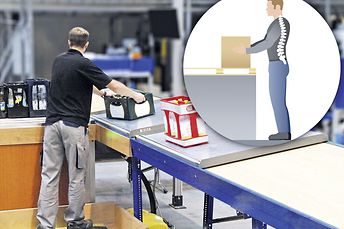Ergonomics in Action
As ergonomics seems to go hand in glove with another ‘e’ word, expensive, the mere mention of the word is sufficient to strike fear in the hearts of some warehouse executives. It doesn’t have to be that way. Ergonomics is a science concerned with understanding the interactions among humans and other elements of a system, such as jobs, machines/tools, environments and organisations. Put into practice, it contributes to human safety, security, comfort, and the maintenance and improvement of health.
How do we apply ergonomics to a warehouse? For starters, we can make manual handling jobs easier to perform. Do it properly for as many jobs as is feasible and we can maximise productivity and minimise lost workdays.
For me, there are two possible ways to do this. Administratively, we can initiate changes through organising or reorganising the work, modifying work practices so that workers perform work within their power zone (i.e., above the knees, below the shoulders, and close to the body). Technically, we can modify, redesign, provide or replace tools, equipment, workstations, processes, products or materials. I believe a combination of both often yields the best results.
For the purpose of this blog, let us consider how we can apply ergonomics to order picking, a labour intensive activity found in most warehouses and easily the biggest operating cost item for a warehouse operator.

Order picking made safer
While order picking seems like a non-safety issue, that is far from being true. As order pickers bend their backs hundreds of times a day, back injuries while lifting are a common hazard. Equally common are sprains and strains in shoulders, elbows and arms because of exertion and overextension, resulting in off time and associated costs. So how can we make order picking safer?
Administratively, we can organise the warehouse around the Pareto principle. Also known as the 80/20 Rule, it holds true for most things in life, including warehouses. In every warehouse, distribution centre and storage area, there are items that move faster and in higher volume than others. By locating the high movers – the vital 20% – within the shelving system which is most easily accessible, companies can cut down on possible mishaps as well as maximise efficiencies and minimise wasted time and effort.
Administratively, too, companies can decide how to utilise specific areas within their shelving system such as the bottom shelf. Almost all warehouses place their heaviest load on the bottom layer. While it seems logical in the interest of stability, it is clearly not ideal from an order picking standpoint. It requires order pickers to lift the heaviest loads using the worst body posture, as they have to bend at the waist to reach for items located on the shelf.
To strike a balance between companies need to maximise the space for storage and the workers’ need to protect their back, companies can raise the bottom level so that loads are at heights where torso bending is not necessary. Or, they can elevate the pallet by stacking empty pallets beneath.
Technically, companies can make order picking safer for their workers through incorporating gravity fed pallet flow racks, to reduce ergonomic stresses arising from bending and forward stretching for product picks; using conveyors to move cartons, totes and pallets safely, quickly and efficiently within a facility; and repositioning a work table to eliminate the need for a long and/or excessive reach.
The safety, as well as efficiency of order-picking operations, can be raised another notch through investment in goods-to-person order picking system, where the items are delivered to modular workstations using conveyor or a transportation system. The workstations can be customised to maximise the pickers’ well-being and improve their performance.
Someone once said ergonomically designed workplaces is one of the best investments with highest return on investment. I can’t agree more, as stress and strains, whether they result in dull, achy, sharp or stabbing pain, make that it hard to concentrate on work. And once we lose concentration, we make mistakes. Correcting mistakes can be a real pain!